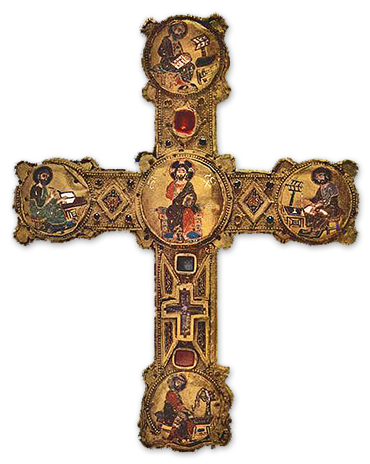
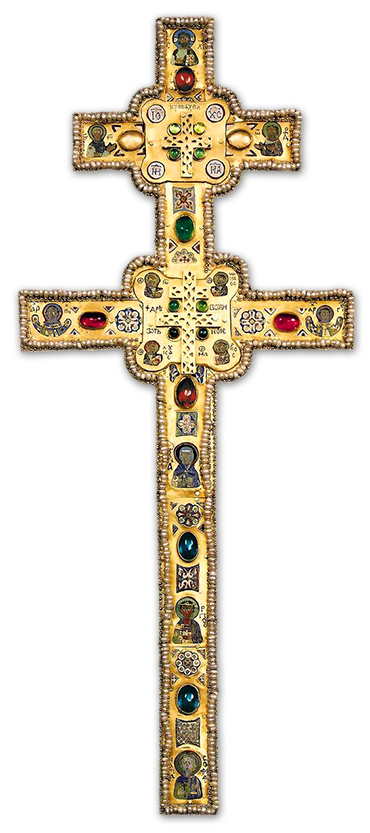
![]()
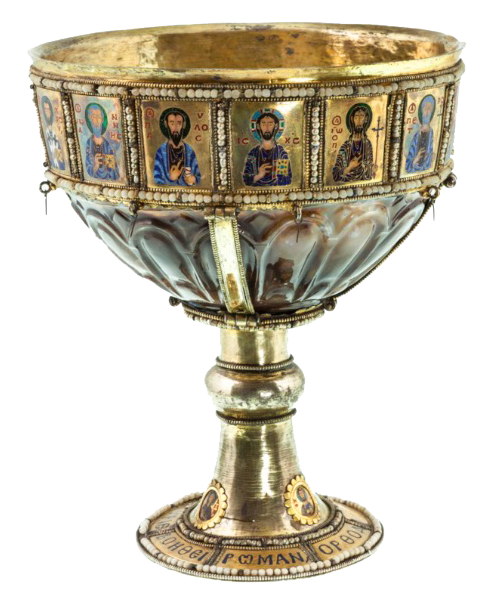
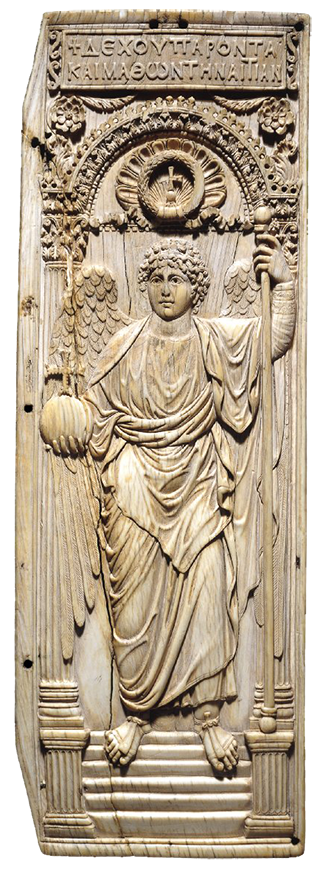

Narratio de S. Sophia, 7ff:
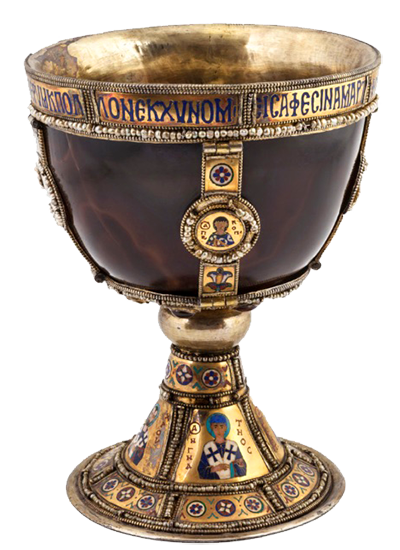 7. There were a hundred master craftsmen, and each one whom had a hundred men, so that all together there were ten thousand, Fifty master craftsmen with their people were building the right-hand side, and the other fifty were like-wise building the left-hand side, so that the work would proceed quickly, in competition and haste.
7. There were a hundred master craftsmen, and each one whom had a hundred men, so that all together there were ten thousand, Fifty master craftsmen with their people were building the right-hand side, and the other fifty were like-wise building the left-hand side, so that the work would proceed quickly, in competition and haste.
8. The shape of the church was revealed to the emperor by an angel of the Lord. The master builder was the engineer Ignatius, a man possessed of great wisdom and experienced in the building of churches. Barley was cooked in cauldrons. and its juice, instead of water, was mixed with lime and crushed brick, the juice being sticky, good for mixing and adhesive. They also cut to pieces the bark of elms and put it in the caldrons together with the barley. They made square masses, fifty cubits long and fifty cubits wide and twenty cubits thick, and they placed these in the foundations, and they used the mixture neither hot or cold, but lukewarm because that way it would be adhesive. And above this mass they placed big stones, equal in length and width, and they could be seen to hold like iron.
9. When the foundation was raided two cubits above the ground - as stated by the above mentioned Strategius, the emperor's adopted brother, who kept the accounts - there had been expended 452 kentenaria of gold. Every day silver pieces were brought from the stones received one silver piece per day so they would loose heart or the palace and placed at the Horologion, and those who carried up the curse... When the piers had been raised and the great columns (both those of Roman stone and the green ones) had been set up, the emperor did not sleep in the afternoon, but showed much solicitude and zeal in observing the stone-carvers, masons, carpenters and other builders...
10. When they had erected the arches of the right-hand and left-hand galleries and roofed them with vaults, the emperor decreed that on a Saturday silver pieces should be brought from the palace...
11. When the builders had reached the second gallery and had erected the upper columns and the vaults, and had roofed everything all round, the emperor was dispirited because he did hot have a sufficient quantity of gold...
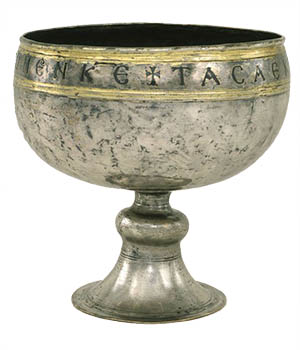 12. When he was about to complete the holy presbytery and light it by means of glazed windows, he ordered the engineer that the apse should have one arched opening; but then he changed his mind and ordered that it should have two lights, i.e, two arches so as to educe the weight; inasmuch as they as not set up a centering there, just as they had not done so in the narthex and on the sides of the church. But as the other craftsmen objected, saying that one arch would light the presbytery sufficiently, the master-builder was at a loss what to do, since sometimes the emperor said there should be one arch, and at other times two; and as he stood there in distress it was a Wednesday, and in the fifth hour), there appeared to him an angel of the Lord in the likeness of Justinian, wearing the imperial vestments and red bushkins, and said to the craftsman: "I wish that you make me the apse with three lights by means of three arches, in the name of the Father, the Son and the Holy Ghost"...'
12. When he was about to complete the holy presbytery and light it by means of glazed windows, he ordered the engineer that the apse should have one arched opening; but then he changed his mind and ordered that it should have two lights, i.e, two arches so as to educe the weight; inasmuch as they as not set up a centering there, just as they had not done so in the narthex and on the sides of the church. But as the other craftsmen objected, saying that one arch would light the presbytery sufficiently, the master-builder was at a loss what to do, since sometimes the emperor said there should be one arch, and at other times two; and as he stood there in distress it was a Wednesday, and in the fifth hour), there appeared to him an angel of the Lord in the likeness of Justinian, wearing the imperial vestments and red bushkins, and said to the craftsman: "I wish that you make me the apse with three lights by means of three arches, in the name of the Father, the Son and the Holy Ghost"...'
13. All of the piers, both inside and out, are held by iron tie-rods set in solder as as to be firm and unmoving. The rendering of all of the piers was of oil mixed with lime, and upon this they set up the variegated marble revetments.
14. The emperor dispatched Troilus the chamberlain, Theodore the prefect and Basilides the questor to the island of Rhodes and there they made out of clay enormous bricks of equal weight and size with they stamped with these words: "god is in the midst of her, and she shall not be moved. God shall help her, and that right early." And counting their number, they shipped them to the emperor. The weight of twelve such bricks is equal to the weight of one of our bricks because that clay is very light, spongy and of a white color. Hence a popular tale has spread abroad that some of the dome is made of pumice, but it a not so, except that it is light. With these bricks they built the four enormous arches and they started to round off the dome, they would set up to twelve bricks, and between each twelve the priests made a prayer for the establishment of the church.. Every twelve bricks the builders made a hole and they inserted in the holes sacred relics of different saints; this they did until they finished the dome. Boldly, it stood straight up.
15. After they had finished the beautiful marble revetments, the emperor gilded the joints of the revetment, the column capitals, the carvings and the cornices of the second and third stories. All of these he gilded with pure gold two fingers thick, And as for the entire ceiling, i.e., of the galleries and the aisles and around, and of the four narthexes, he gilded them with gleaming gold glass, all the way to the surrounding forecourts. The pavement of the church he decorated with various costly marbles which he polished and laid down, as for the outer sides and surrounding areas, he paved them with very big, costly slabs of white marble.
16. The hold presbytery he made with of shining silver. The parapets and columns he sheathed entirely in silver together with their doors - all of silver plated with gold. He set up in the presbytery for silver tables on columns, and these, too, he gilded. He also gilded the seven steps on which the priests sit, together with the bishop's throne and the four silver columns erected two on each side, by the entrance to the tunnel called kuklion, with is underneath the steps; this he called the Holy of Hoies. Furthermore, he erected big silver-gilt columns together with the ciborium and the lilies. The ciborium he made of silver and niello. On top of the ciborium he set up a globe of pure gold weighing 118 lbs. and golden lilies weighing 4 lbs. each, and above these a golden cross with precious and rare stones, which cross weighed 80 lbs. of gold.
17. He also adopted the following device. Wishing to make the altar table much costlier than gold, he called in many specialists and told them so. They said to him: "Let us place in a smelting -furnace gold, silver various precious stones, earls and mother of pearl, copper, electrum, lead, iron, tin, glass and every other metallic substance." Having ground all of these in mortars and bound them up, they poured then into the smelting-furnace. After the fire had kneaded together substances, the craftsmen removed them from the fire and poured them into a mold, as so the altar-table was cast, a priceless mixture. In this way he set it up, and underneath it it he placed columns of pure gold with precious stones and enamels, and the stairs all around where the priests stand to kiss the altar-table, he made it o priceless stones and gilded it. Who can behold the appearance of the altar-table without being amazed? Who indeed can comprehend it as it changes color and brilliance, sometimes appearing to be gold, in other places silver, in another gleaming with sapphire - in a word, reflecting seventy-two hues according to the nature of the stones pearls and all the metals?
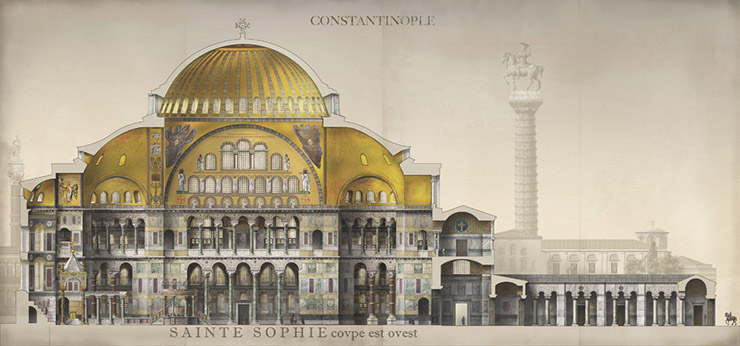 18. He also made the doorways below and above toi the number of 365. At the first entrance coming from the atrium three made doorways of electrum, and in the second narthex he made three ivory doors on the left side and three on the right, and in the middle three doorways, namely two matching ones, and one very big, of gilded silver, and all of the doors he gilded. Inside of these three doors, instead of ordinary wood, he placed wood from the Ark...
18. He also made the doorways below and above toi the number of 365. At the first entrance coming from the atrium three made doorways of electrum, and in the second narthex he made three ivory doors on the left side and three on the right, and in the middle three doorways, namely two matching ones, and one very big, of gilded silver, and all of the doors he gilded. Inside of these three doors, instead of ordinary wood, he placed wood from the Ark...
21. The ambo and the solea he made or sardonyx, and set in the gold columns precious stones, crystal, jasper and sapphire; nd he laid much gold on the upper part of the solea. The ambo had a golden dome with pearls, rubies and emeralds. The cross of the ambo weighed a hundred pounds of gold and it had pendants of rubies and pear-shaped pearls. Up above, instead f parapets, the ambo had awnings of pure gold...
23. He also made golden vessels, those for the twelve feasts and others, namely holy Gospel books, basins, pitchers, chalices, and patens; all made of pure gold wit stones and earls, and the number of holy vessels was one thousand; three hundred corrugated gold altar covers with precious stones and one hundred crowns so that there could be a different one for each feast day; one thousand chalice-covers and paten-covers, all of gold with pearls and priceless stones; twenty-four Gospel books, each weighing two kentenara; thirty-six golden censers with precious stones, two hundred golden lamps each weighing 40 lbs., six thousand golden polykandela and lamps in the form of a vine for the narthex, the ambo, the bema and the two women's galleries....
24. He also made five crosses of Gold, each weighing one kentenarion, and decorated them with various costly stones so that they are valued at eight kentenaria each; two golden manualia with precious stones and huge pearls which have been valued at five kentenaria of gold, two other very large manualia of carved crystal having feet of pure gold. each worth one kentenarion of gold. He also made four golden candlesticks with precious stones, each worth one kentenartion, to be placed upon the golden and crystal manualia; another fifty large manualia of silver and two hundred of a man's height, also of silver, to stand in the choir.
25. Upon the ambo he extended a year's taxes received from Egypt alone, 365 kentenaria; this is extended on the ambo and the solea... The entire church, together with its outer surroundings, but without the holy vessels, other furnishings ad donations made from all parts of the Empire, represents all together an outlay of 3200 kentenaria of minted gold.
26. Justinian alone began the church and he alone finished it with no help from any one else with regard to the building, for all around it shone with gold and silver. And the floor, too, made visitors marvel at it for it appeared like the sea or the flowing waters of a river thanks to the great variety of its marble. The four strips of the church he called the Four Rivers that flow out of paradise, and he decreed that persons excommunicated for their sins should stand upon them, one by one. In the atrium he made twelve conduits and stone lions that spouted water for the ablutions of the common people. On the right-hand side of the women's gallery he made a pool in which water collected to the depth of one span, and a gangway for the priests to walk over the pool. Facing the pool he set set up a cistern of rainwater, an he carved twelve lions, twelve leopards, twelve deer, twelve eagles, twelve hares, twelve calves and twelve crows, out of whose throats water flowed by means of a mechanism for the ablution of the priests alone. he called this place Leontarion. There, to, he constructed the metatorium, a beautiful chamber covered with gold, so that he might rest there whenever he went to the church. Who can relate the excessive beauty of this church, sheathed in gold and silver from floor to ceiling?
27. Having completed the church and the holy offerings, on the 22nd of December, he came out of the palace in procession, sitting on a chariot drawn by four horses...
28. The dome that was boldly built by Justinian, the precious and glorious ambo worthy of all admiration, the solea and the variegated floor of the church lasted seventeen years. After Justinian's death, his nephew Justin became ruler and in the second year of his reign, on a Thursday, in the sixth hour of the day, the dome fell down and crushed the wonderful ambo and the solea with all their sardonyx, sapphires, mother of pearl, pearls, the gold and crystal parapets, the silver columns and the precious pavement. The four arches, however, the columns and the remaining structure stood unshaken. The emperor called in the engineer who had labored there and which was still alive and asked him what had happened to cause the destruction of the dome. He replied; "Your uncle was too hasty in removing the wooden supports that were i the dome so as to cover it with mosaic, and he made it too high, so as to be seen from everywhere. Also when the workmen cut down the scaffolding they threw down the timbers and from their weight the foundations were shattered, as so the dome fell down." The men of the craft spoke to the emperor and told him this: "If you wish, O Lord, that the dome can be made flat like a cymbal, send emissaries to the island of Rhodes as your uncle did, and let them bring bricks of the original size, made of the same clay and bearing the same stamp". In this manner he dome was vaulted. They reduced it's former height by five fathom and made it in the shape of a drum. Fearing lest it fall down again in short time, they left the timbers and the supports in place for a year until they were satisfied that the dome had set. As for the ambo and the solea, he as unable to make them as lavish and precious as before, so he made the ambo cheaply out of stones and columns covered in silver, parapets, curtains and surrounds also of silver, and he dud the same for the solea. He did not wish to make a cupola for the ambo due to the great expense, as he said. For the floor he was unable to find slabs of such great size and variety, so he sent Manasses, patrician and praepostius, to Proconnesus to cut slabs that would denote the earth, which the green ones signify the rivers that flow into the sea.
29. When they cut down the scaffolding from the dome and were about to take the timbers down, they filled the church with water to a depth of five cubits and threw the timbers down and these floated in water and did not shatter the foundations. In this manner the church was completed: wherefore some people say that Justin built it, but this is untrue.

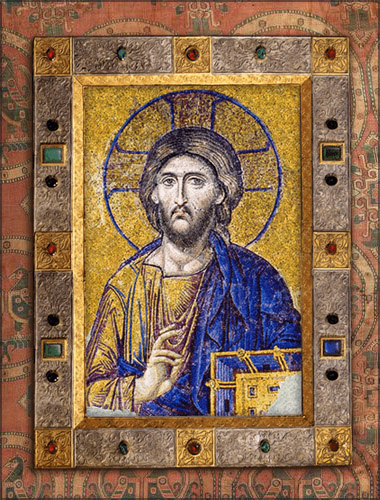



![]()


 click here for icons of christ
click here for icons of christ click here for icons of the theotokos
click here for icons of the theotokos click here for icons of angels
click here for icons of angels click here for icons of saints
click here for icons of saints